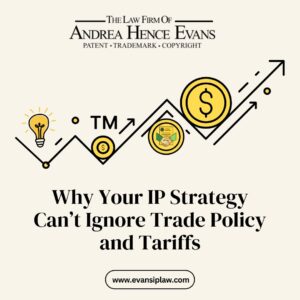Why Your IP Strategy Can’t Ignore Trade Policy and Tariffs
When most businesses think about intellectual property (IP), they focus on protecting their innovations and brand reputation. But as global supply chains shift and trade tensions rise, it’s increasingly important to understand how tariffs—those taxes on imports and exports—can shape your patent and trademark strategy.
Let’s break down what this means for your business.
1. Tariffs Can Shift Manufacturing—and That Impacts Patent Strategy
When tariffs make it more expensive to import from certain countries, companies often relocate manufacturing to alternative markets. If you’re moving production to Vietnam, Mexico, or India, for example, consider this:
-
You may need patent protection in your new manufacturing country. Without local patent filings, competitors in those countries may be able to legally manufacture or export your invention.
-
Utility model protection (often available in countries like China or Germany) might be a quicker, cost-effective alternative to full patents, depending on your product.
Pro Tip: A flexible international patent strategy—especially under the Patent Cooperation Treaty (PCT)—can help you stay ahead of shifting supply chains.
2. Tariffs May Change Your Branding or Distribution—and That Impacts Trademark Strategy
Imagine this scenario: You’ve been sourcing apparel from China, but due to high tariffs, you switch to a supplier in Bangladesh. The new factory uses a slightly different fabric or cut. Over time, this could affect:
-
Product quality and consumer perception, which ties directly to your brand reputation.
-
Territorial trademark coverage, especially if your brand name is being used (or misused) in your new manufacturing or distribution country.
Also, if your goods are being held at the border due to counterfeit concerns, you may need to record your trademark with U.S. Customs and Border Protection (CBP) to help block unauthorized imports.
3. Tariffs Can Spark Counterfeiting and Gray Market Goods
Tariffs can increase the cost of genuine goods, giving counterfeiters an opportunity to undercut legitimate brands. Additionally, foreign distributors may try to bring authentic products into the U.S. outside of your authorized channels—so-called gray market goods.
What you can do:
-
Strengthen your trademark enforcement plan by monitoring for infringements.
-
Use customs enforcement tools to stop counterfeits and gray market goods at the border.
-
Include IP clauses in supplier contracts to protect your trademarks and inventions abroad.
4. It’s Time for a Global IP Audit
Tariff policy can change rapidly depending on global politics, elections, and trade agreements. That’s why we recommend a proactive, global IP audit:
-
Are your trademarks registered in countries where you manufacture, distribute, or sell?
-
Do you have patent protection in jurisdictions that matter to your current and future supply chain?
-
Are your license and manufacturing agreements up-to-date to reflect new tariffs, sourcing, or export plans?
Schedule a consultation with The Law Firm of Andrea Hence Evans, LLC to discuss your IP strategy and global IP audit. www.evansiplaw.com

